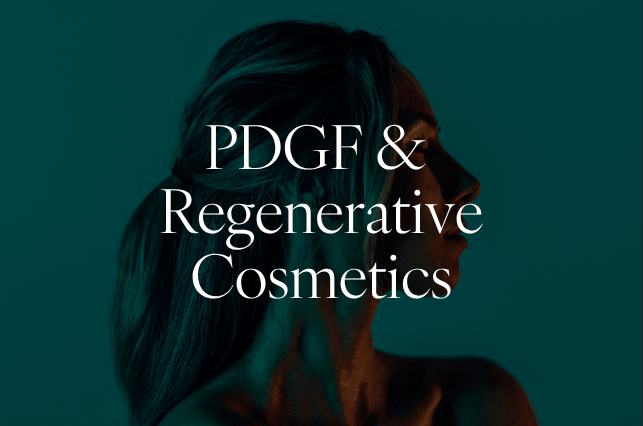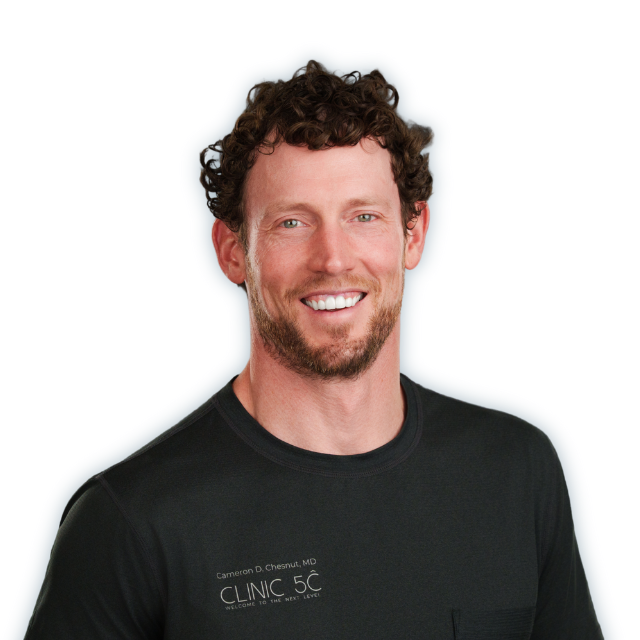PDGF: The Growth Factor Changing the Future of Regenerative Aesthetics (and Why It’s Not Just Hype)

Platelet-Derived Growth Factor, or PDGF, is being called everything from "the next big thing in regenerative aesthetics" to "another overhyped trend". But beneath the buzz lies decades of legitimate science.
“PDGF isn’t new,” says Dr. Cameron Chesnut, double board-certified surgeon and regenerative medicine expert at Clinic 5C. “PDGF is one of the most powerful growth factors identified in wound healing, discovered in the 1970s, FDA-approved in the 1990s for tissue repair, and still foundational to how our bodies regenerate today.”
What Is PDGF?
PDGF is a naturally occurring protein released by platelets, macrophages, and endothelial cells during the body’s healing process. (1.) It plays a key role in cell proliferation, angiogenesis (the formation of new blood vessels), and collagen remodeling, which are all fundamental mechanisms of repair.
Unlike peptides, which are short chains of amino acids, PDGF is a full protein, giving it greater complexity and more far-reaching cellular signaling. (2.) “This is not a fringe peptide or cosmetic gimmick,” says Dr. Chesnut. “It’s a biologically validated protein that drives real regeneration.”

How PDGF Works in Regenerative Aesthetics
In aesthetic medicine, PDGF is part of the same biologic family of regenerative factors used in PRP (platelet-rich plasma) and PRF (platelet-rich fibrin) therapies. These treatments use a patient’s own blood to release a cascade of growth factors for skin repair, including PDGF, that stimulate healing and rejuvenation from within.
PDGF binds to specific receptors on fibroblasts and smooth muscle cells, triggering them to proliferate and produce extracellular matrix components such as collagen and elastin. (4.) This process enhances tissue strength, improves elasticity, and accelerates recovery. This is the same biologic foundation now being explored in cosmetic skin rejuvenation and injectable biostimulants.
Is PDGF Injectable?
Currently, PDGF is FDA-approved for topical use only, primarily in wound-healing applications such as diabetic ulcers and postsurgical recovery. (5.) Some clinicians are experimenting with injectable formulations, but these are off-label and unregulated.
“Right now, PDGF injection is not an approved indication,” Dr. Chesnut notes. “It’s similar to what we see in functional medicine when providers use research-grade peptides like BPC-157 or TB-500. The science is compelling, but clinical use must remain cautious and evidence-driven.”
PDGF vs. PRP vs. Exosomes
Why Platelet-Derived Growth Factor Matters
What sets PDGF apart is its scientific longevity and proven mechanism. “It’s been around for over 50 years,” says Dr. Chesnut. “It’s FDA-approved for wound healing. (3.) That means it’s passed some of the most rigorous regulatory hurdles in medicine. You can’t say that for most emerging peptides or cosmetic actives.”
The growing interest in PDGF reflects a broader shift in aesthetic medicine: away from purely volumetric treatments like filler, and toward cellular-level regeneration that improves the skin’s own ability to heal, strengthen, and age gracefully.
The Clinic 5C Perspective
Dr. Chesnut’s approach to regenerative aesthetics blends clinical precision with biologic intelligence. “We’ve entered an era where the best aesthetic outcomes come from triggering the body’s repair mechanisms, not fighting against them,” he says.
While PDGF injections remain experimental, the science behind them signals a clear direction for the future. One where true rejuvenation is achieved through biology, not camouflage.
Discover more of our Regenerative Medicine in Spokane for cosmetics and injury recovery. Inquire for more non-surgical skin regeneration options here.
References
- Heldin, C.H., Westermark, B. Platelet-derived growth factor: mechanism of action and physiological roles. Physiol Rev. 1999;79(4):1283–1316.
- Andrae, J., Gallini, R., Betsholtz, C. Role of platelet-derived growth factors in physiology and medicine. Genes Dev. 2008;22(10):1276–1312.
- Pierce, G.F. et al. Platelet-derived growth factor and fibroblast growth factor stimulate wound healing in normal and genetically diabetic mice. J Clin Invest. 1989;84(2):640–646.
- Li, X. et al. PDGF signaling in fibroblast and vascular biology. Front Cell Dev Biol. 2020;8:559.
- FDA Approval: Regranex® (becaplermin) Gel 0.01%. U.S. Food and Drug Administration, 1997.
Ready to begin your wellness journey?
Fax: (844) 961-3417
Fax: (844) 927-4793



